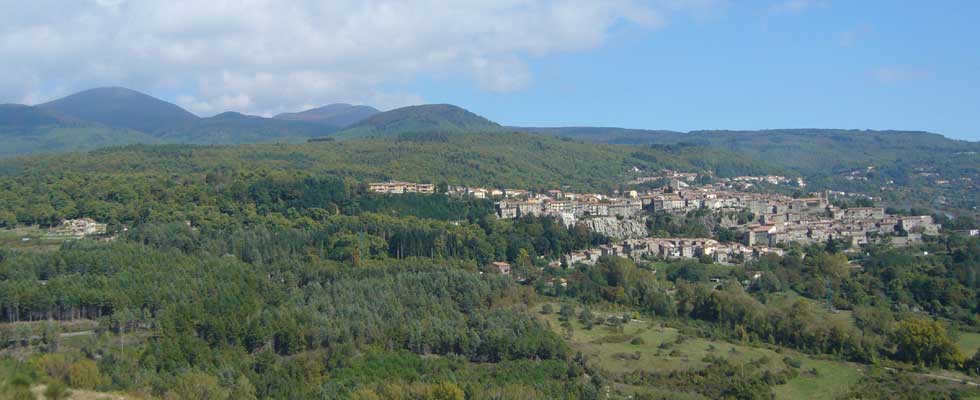
| Weather forecast | Web cam | Weather station | Contact us | Photo Gallery | Links | Search |
| Getting there | Nature | Culture | Epicurean living | Activities | Routes | Our hotel |
| Culture on Monte Amiata |
| Cultural holiday packages |
Padre Ernesto Balducci
"When I was twelve, instead of preaching in the temple like Jesus, I put on a little overall and went into a blacksmith's workshop. I did my eight hours' work every day for almost six months. I helped shoe horses and donkeys, build bed frames, weldbits of iron together, shape reinforcing rods on the anvil andfinish pieces of work off, file in hand, in the vice. Some of myfriends smile at these memories as if I were just trying to attract attention, but in reality I know what it's like to carry the yoke of hardship. I remember the day when I was sitting on the steps of our house and my father told me that I'd have to give up my mania for book for ever because he'd already found me a job. He was unemployed at the time and couldn't make ends meet. I cried, but without rebellion. I started my new life, which would have been definitive, but the Scolopi heard about me through a friend of my mother, Domenico Bulgarini, writer and literary agent (and later a publisher himself), and offered me a free place in November 1934. The truth of the matter is that I had abandoned my deepest aspirations without reservations. I had made the same sacrifice as Abraham, and those six months were an extraordinary schooling.The blacksmith, name of Manfredi, was an anarchist persecuted by fascism. He was profoundly wise and of robust moral dignity,and taught me to look at things from below with an open mind and with anger, but also with a sense of humour. In the toilet of the workshop the following writing stood out: ``Saranno grandi i papi, / saran potenti i re, / ma quando qui si seggono, / son tutti come me'' (``The popes might be great, / the kings might be mighty, / but when they sit down here, / they're all just like me''). And he swore with great imagination while he beat the iron on the anvil. My mother had warned me about this, but in the longrun, thanks to Manfredi, I was able to tell the differenc ebetween working-class swearing, which is a religious phenomenon, and middle-class swearing, which is repulsive cynicism. When Itold him that I was leaving for the Scolopi's College the following day, he put his hands on my shoulders and said solemnly: ``Don't let yourself be fooled by the priests!''. Thirty years later, when the newspapers were talking about my conviction for the defence of conscientious objection, I happened to be in the graveyard in front of my father's gravestone. I hadn't seen Manfredi any more. He came up to me, touched my shoulder and said, as if we had parted company the day before,``Ernesto, they didn't manage it!''. His pride touched me deeply like a blessing from God."
( From ``The Closed Circle'', an interview held by Luciano Martini)
Father Ernesto Balducci (6 August 1922, Santa Fiora, Tuscany, Italy - 25 April 1992) was an Italian Roman Catholic priest and peace activist. When Ernesto Balducci was twelve, his father was laid off and the Scolopi, a religious foundation dedicated to the education of the poor, offered him a free place in seminary. He studied theology at Rome, then Letters and Philosophy at Florence.The foundation of the Centro d'Impegno Cristiano "Cenacolo" (Centre for Christian Commitment) in 1952 gave him the chance to intensify both his friendship with the charismatic mayor of Florence Giorgio La Pira ,and his relationship with the author-priest Lorenzo Milani and the disciples of Jacques Maritain, known as the 'Little Brothers'. In 1958 Balducci founded the monthly review Testimonianze (“Testimonies”), which he directed for 34 years. In 1963 he openly defended the first Italian conscientious objector, Giuseppe Gozzini. His articles, and the subsequent trial, gave the bishop of Florence, monsignor Florit, the opportunity to “exile” Balducci. He stayed in Rome, very near the Second Vatican Council, until 1965 when, thanks to the direct intervention of Pope Paul VI, he went back to Tuscany. Not in Florence, however, where bishop Florit was still involved in his confrontation against La Pira, but at the abbey named Badia Fiesolana, two hundred yards from the border of the diocese of Florence.
Despite the isolation of the abbey, he had less and less time for his studies, as most of his days were taken up by the magazine Testimonianze, by the publishing house “Cultura della pace”, (“Peace culture”), by his cooperation with daily papers and other periodical and by his direct and unflagging attendance at dozens of demonstrations and debates all over Italy. He campaigned against the grounds of war, both before and after the Gulf war, and used the five hundredth anniversary in 1992 of the Christopher Columbus’ discovery of America, as the occasion to put the very foundations of modernity in question, and these campaigns became a point of reference for the large Italian peace movement. It was while returning from one of these debates that Ernesto Balducci was involved in a car accident. He was admitted to hospital in coma, and died on 25 April 1992.